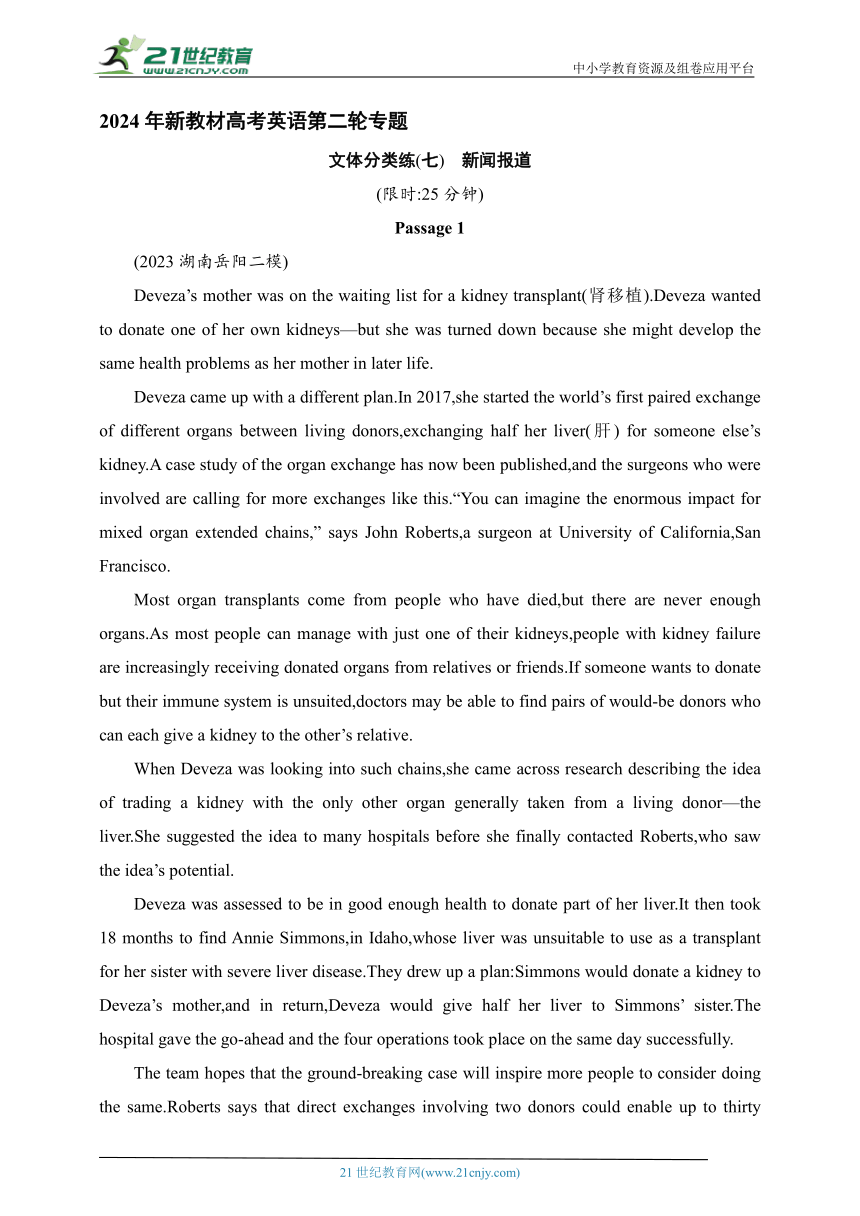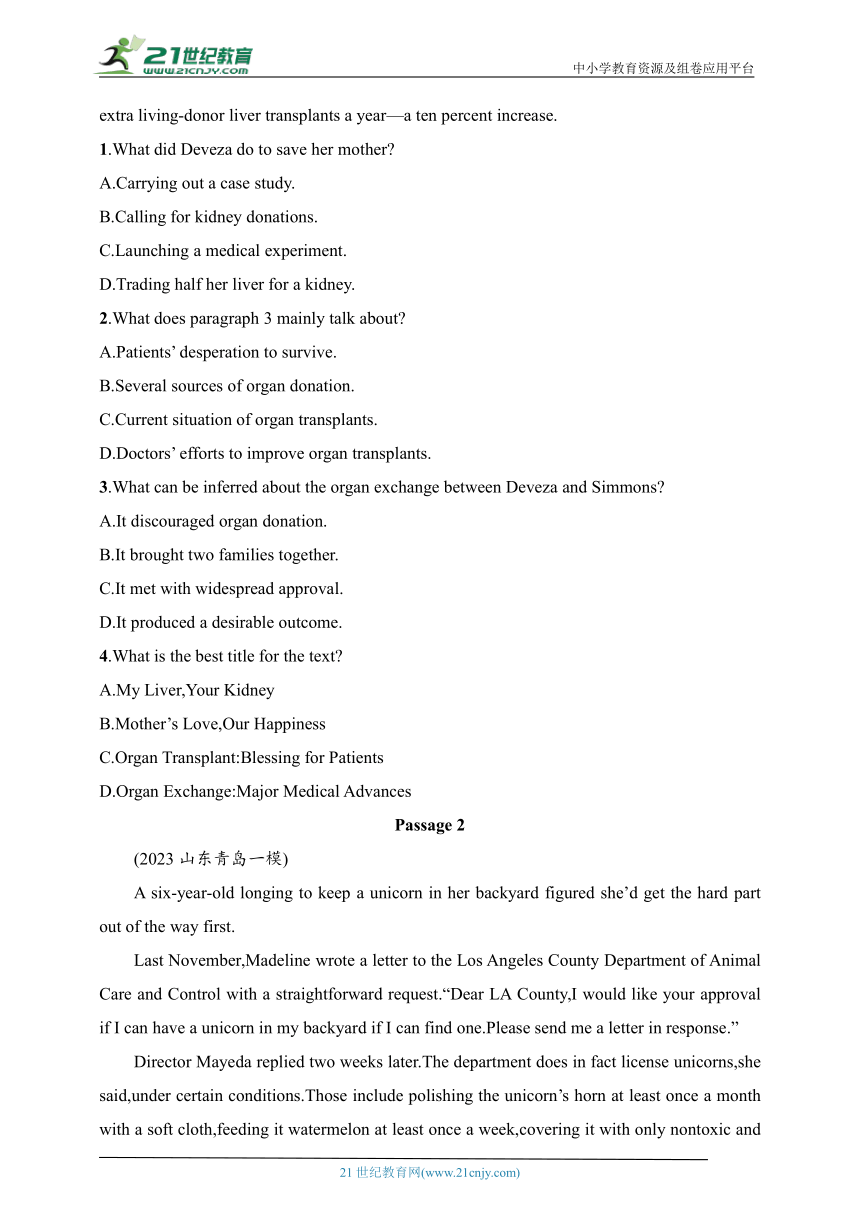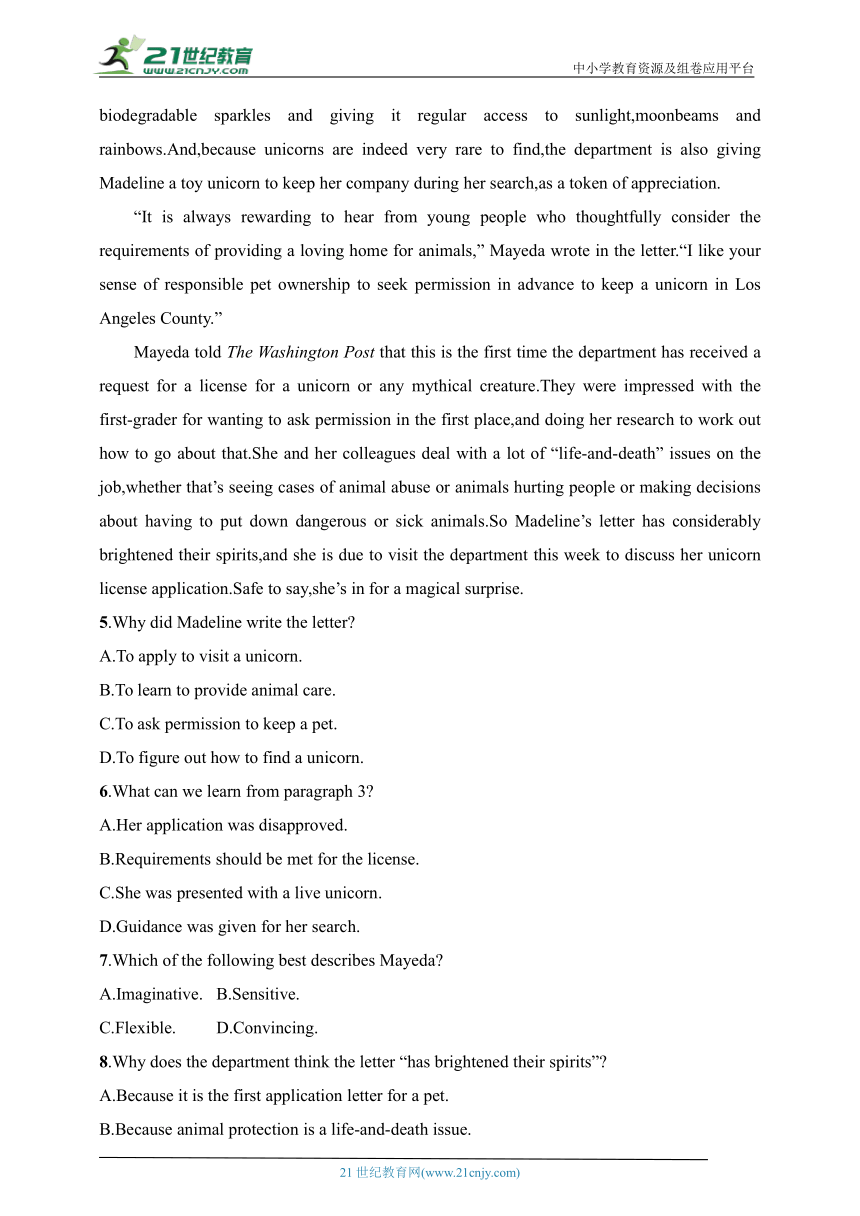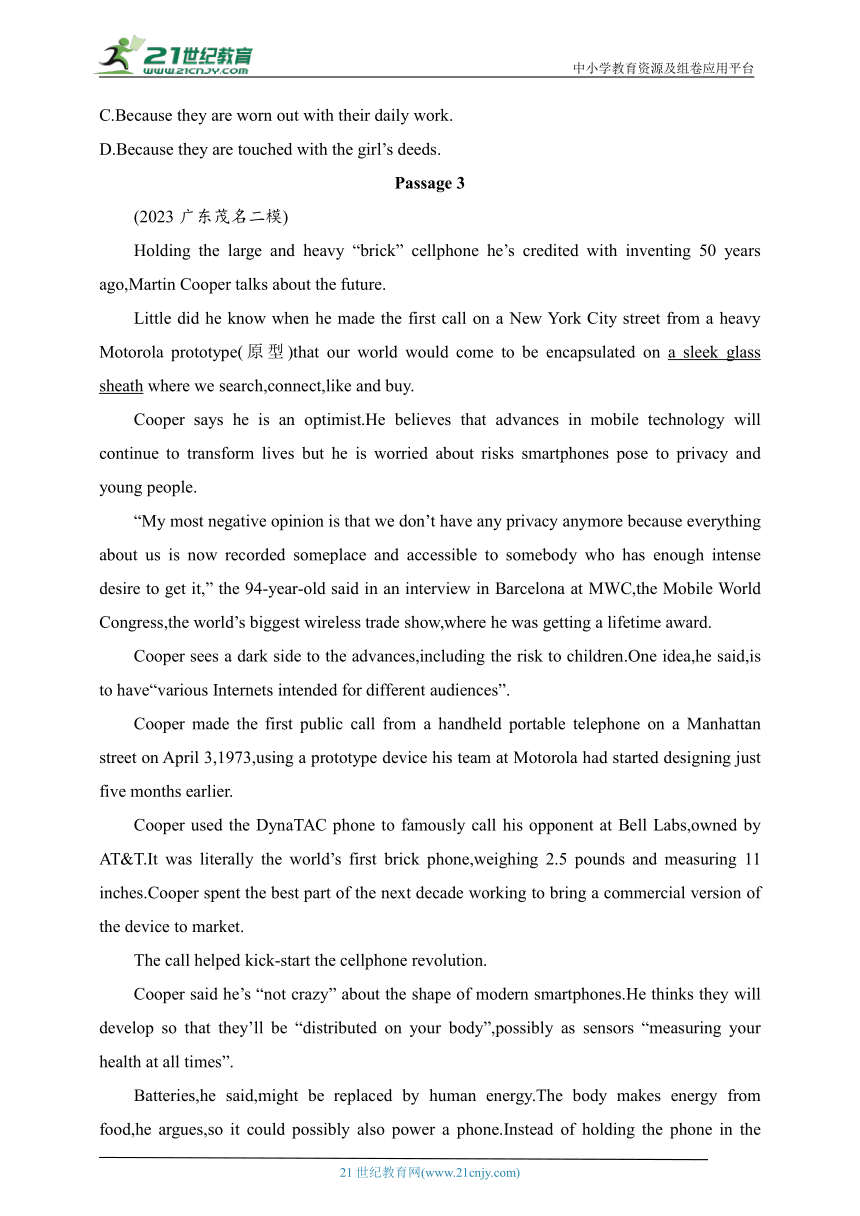2024年新教材高考英语第二轮专题练习--阅读理解 文体分类练7 新闻报道(答案与解析)
文档属性
| 名称 | 2024年新教材高考英语第二轮专题练习--阅读理解 文体分类练7 新闻报道(答案与解析) |  | |
| 格式 | docx | ||
| 文件大小 | 1.0MB | ||
| 资源类型 | 试卷 | ||
| 版本资源 | 通用版 | ||
| 科目 | 英语 | ||
| 更新时间 | 2023-10-25 16:13:54 | ||
图片预览




文档简介
中小学教育资源及组卷应用平台
2024年新教材高考英语第二轮专题
文体分类练(七) 新闻报道
(限时:25分钟)
Passage 1
(2023湖南岳阳二模)
Deveza’s mother was on the waiting list for a kidney transplant(肾移植).Deveza wanted to donate one of her own kidneys—but she was turned down because she might develop the same health problems as her mother in later life.
Deveza came up with a different plan.In 2017,she started the world’s first paired exchange of different organs between living donors,exchanging half her liver(肝) for someone else’s kidney.A case study of the organ exchange has now been published,and the surgeons who were involved are calling for more exchanges like this.“You can imagine the enormous impact for mixed organ extended chains,” says John Roberts,a surgeon at University of California,San Francisco.
Most organ transplants come from people who have died,but there are never enough organs.As most people can manage with just one of their kidneys,people with kidney failure are increasingly receiving donated organs from relatives or friends.If someone wants to donate but their immune system is unsuited,doctors may be able to find pairs of would-be donors who can each give a kidney to the other’s relative.
When Deveza was looking into such chains,she came across research describing the idea of trading a kidney with the only other organ generally taken from a living donor—the liver.She suggested the idea to many hospitals before she finally contacted Roberts,who saw the idea’s potential.
Deveza was assessed to be in good enough health to donate part of her liver.It then took 18 months to find Annie Simmons,in Idaho,whose liver was unsuitable to use as a transplant for her sister with severe liver disease.They drew up a plan:Simmons would donate a kidney to Deveza’s mother,and in return,Deveza would give half her liver to Simmons’ sister.The hospital gave the go-ahead and the four operations took place on the same day successfully.
The team hopes that the ground-breaking case will inspire more people to consider doing the same.Roberts says that direct exchanges involving two donors could enable up to thirty extra living-donor liver transplants a year—a ten percent increase.
1.What did Deveza do to save her mother
A.Carrying out a case study.
B.Calling for kidney donations.
C.Launching a medical experiment.
D.Trading half her liver for a kidney.
2.What does paragraph 3 mainly talk about
A.Patients’ desperation to survive.
B.Several sources of organ donation.
C.Current situation of organ transplants.
D.Doctors’ efforts to improve organ transplants.
3.What can be inferred about the organ exchange between Deveza and Simmons
A.It discouraged organ donation.
B.It brought two families together.
C.It met with widespread approval.
D.It produced a desirable outcome.
4.What is the best title for the text
A.My Liver,Your Kidney
B.Mother’s Love,Our Happiness
C.Organ Transplant:Blessing for Patients
D.Organ Exchange:Major Medical Advances
Passage 2
(2023山东青岛一模)
A six-year-old longing to keep a unicorn in her backyard figured she’d get the hard part out of the way first.
Last November,Madeline wrote a letter to the Los Angeles County Department of Animal Care and Control with a straightforward request.“Dear LA County,I would like your approval if I can have a unicorn in my backyard if I can find one.Please send me a letter in response.”
Director Mayeda replied two weeks later.The department does in fact license unicorns,she said,under certain conditions.Those include polishing the unicorn’s horn at least once a month with a soft cloth,feeding it watermelon at least once a week,covering it with only nontoxic and biodegradable sparkles and giving it regular access to sunlight,moonbeams and rainbows.And,because unicorns are indeed very rare to find,the department is also giving Madeline a toy unicorn to keep her company during her search,as a token of appreciation.
“It is always rewarding to hear from young people who thoughtfully consider the requirements of providing a loving home for animals,” Mayeda wrote in the letter.“I like your sense of responsible pet ownership to seek permission in advance to keep a unicorn in Los Angeles County.”
Mayeda told The Washington Post that this is the first time the department has received a request for a license for a unicorn or any mythical creature.They were impressed with the first-grader for wanting to ask permission in the first place,and doing her research to work out how to go about that.She and her colleagues deal with a lot of “life-and-death” issues on the job,whether that’s seeing cases of animal abuse or animals hurting people or making decisions about having to put down dangerous or sick animals.So Madeline’s letter has considerably brightened their spirits,and she is due to visit the department this week to discuss her unicorn license application.Safe to say,she’s in for a magical surprise.
5.Why did Madeline write the letter
A.To apply to visit a unicorn.
B.To learn to provide animal care.
C.To ask permission to keep a pet.
D.To figure out how to find a unicorn.
6.What can we learn from paragraph 3
A.Her application was disapproved.
B.Requirements should be met for the license.
C.She was presented with a live unicorn.
D.Guidance was given for her search.
7.Which of the following best describes Mayeda
A.Imaginative. B.Sensitive.
C.Flexible. D.Convincing.
8.Why does the department think the letter “has brightened their spirits”
A.Because it is the first application letter for a pet.
B.Because animal protection is a life-and-death issue.
C.Because they are worn out with their daily work.
D.Because they are touched with the girl’s deeds.
Passage 3
(2023广东茂名二模)
Holding the large and heavy “brick” cellphone he’s credited with inventing 50 years ago,Martin Cooper talks about the future.
Little did he know when he made the first call on a New York City street from a heavy Motorola prototype(原型)that our world would come to be encapsulated on a sleek glass sheath where we search,connect,like and buy.
Cooper says he is an optimist.He believes that advances in mobile technology will continue to transform lives but he is worried about risks smartphones pose to privacy and young people.
“My most negative opinion is that we don’t have any privacy anymore because everything about us is now recorded someplace and accessible to somebody who has enough intense desire to get it,” the 94-year-old said in an interview in Barcelona at MWC,the Mobile World Congress,the world’s biggest wireless trade show,where he was getting a lifetime award.
Cooper sees a dark side to the advances,including the risk to children.One idea,he said,is to have“various Internets intended for different audiences”.
Cooper made the first public call from a handheld portable telephone on a Manhattan street on April 3,1973,using a prototype device his team at Motorola had started designing just five months earlier.
Cooper used the DynaTAC phone to famously call his opponent at Bell Labs,owned by AT&T.It was literally the world’s first brick phone,weighing 2.5 pounds and measuring 11 inches.Cooper spent the best part of the next decade working to bring a commercial version of the device to market.
The call helped kick-start the cellphone revolution.
Cooper said he’s “not crazy” about the shape of modern smartphones.He thinks they will develop so that they’ll be “distributed on your body”,possibly as sensors “measuring your health at all times”.
Batteries,he said,might be replaced by human energy.The body makes energy from food,he argues,so it could possibly also power a phone.Instead of holding the phone in the hand,for example,the device could be placed under the skin.
9.What does the underlined part “a sleek glass sheath” in paragraph 2 refer to
A.A smartphone. B.A Motorola prototype.
C.A “brick” cellphone. D.An original cellphone.
10.What is Cooper’s attitude about the future of the mobile phone
A.Most negative.
B.Very subjective.
C.Doubtful and disapproving.
D.Optimistic but also concerned.
11.What can be inferred about children from paragraph 5
A.They should be provided with a different Internet from adults.
B.They should have easy access to various Internets.
C.They should be introduced to different audiences.
D.They should use various Internets for learning materials.
12.According to Cooper,how might smartphones be powered in the future
A.By body sensors. B.By human body.
C.By solar energy. D.By advanced batteries.
答案:
文体分类练(七) 新闻报道
Passage 1
[语篇解读]本文是一篇新闻报道。文章主要讲述了Deveza用自己的一半肝脏交换别人的肾脏给自己的妈妈,并取得了成功。这一成功的案例具有积极的影响。
1.D 细节理解题。根据文章第二段内容“Deveza came up with a different plan.In 2017,she started the world’s first paired exchange of different organs between living donors,exchanging half her liver for someone else’s kidney.”可知,Deveza为了帮助妈妈移植合适的肾脏,用自己的一半肝脏作为交换。
2.C 主旨大意题。结合第三段的“...there are never enough organs” “people with kidney failure are increasingly receiving donated organs from relatives or friends”和“doctors may be able to find pairs of would-be donors who can each give a kidney to the other’s relative”可知,该段主要讲述了器官移植的现状。
3.D 推理判断题。根据文章尾段内容可知,她们两个的“器官互换”的成功可以对其他人产生激励作用,从而使直接交换器官的案例增加。由此可推知,这产生了令人满意的结果。
4.A 主旨大意题。通过阅读文章可知,文章第二段中的“In 2017,she started the world’s first paired exchange of different organs between living donors,exchanging half her liver for someone else’s kidney.”为核心话题——文章主要讲述了Deveza用自己的一半肝脏交换别人的肾脏给自己的妈妈,并取得了成功,下文则以此为延伸讲述了其可能产生的积极影响。因此,选项A“My Liver,Your Kidney”不仅贴合主旨,且作为标题更具有吸引力。
Passage 2
[语篇解读]本文是一篇新闻报道。文章主要讲述了六岁的孩子Madeline写信给洛杉矶县动物保护与控制部门,希望获得许可养一只独角兽。
5.C 细节理解题。根据第二段可知,Madeline写这封信是为了请求允许养宠物。
6.B 细节理解题。根据第三段中所列举的饲养独角兽的条件可知,要获得许可应满足一些要求。
7.B 推理判断题。根据倒数第二段中Mayeda的回信内容可推知,Mayeda很体贴。
8.D 推理判断题。根据最后一段内容可知,Mayeda与同事平时要处理许多“生死问题”,他们认为这封信“振奋了他们的精神”,因为他们被女孩认真的行为感动了。
Passage 3
[语篇解读]本文是一篇新闻报道。文章主要讲述了“手机之父”马丁·库珀在接受采访时谈了自己对目前智能手机的一些看法以及他对智能手机未来的一些构想。
9.A 词义猜测题。根据画线词组后的定语从句“where we search,connect,like and buy”可知,该物品能同时让人们搜索、连接网络、点赞以及上网购物,因此画线词组指的是“智能手机”。
10.D 推理判断题。根据文章第三段可知,库珀对智能手机的未来持有乐观的态度,但是不乏抱有担忧。
11.A 推理判断题。根据文章第五段可知,马丁·库珀认为不同的受众应该被提供不同的互联网,也就是说应该给孩子提供不同的互联网。
12.B 细节理解题。根据文章最后一段可知,他认为未来的手机有可能从人体获得能量。
词汇积累:
1.(Passage 1)turn down拒绝
2.(Passage 1)exchange...for...用……来换取……
3.(Passage 1)call for要求
4.(Passage 1)draw up草拟
5.(Passage 2)long to do sth.渴望做某事
6.(Passage 2)approval n.批准
7.(Passage 2)in response作为回应
8.(Passage 3)be credited with doing sth.做某事是……的功劳
9.(Passage 3)literally adv.真正地,确实
熟词生义:
(Passage 1)failure n.衰竭
长难句分析:
(Passage 1)If someone wants to donate but their immune system is unsuited,doctors may be able to find pairs of would-be donors who can each give a kidney to the other’s relative.
分析:本句为复合句。If someone wants to donate but their immune system is unsuited为if引导的条件状语从句;who can each give a kidney to the other’s relative为who引导的定语从句。
句意:如果有人想捐献肾脏,但他们的免疫系统不适合,医生可能会找到一对潜在的捐赠者,他们可以将肾脏捐给对方的亲属。
21世纪教育网 www.21cnjy.com 精品试卷·第 2 页 (共 2 页)
21世纪教育网(www.21cnjy.com)
2024年新教材高考英语第二轮专题
文体分类练(七) 新闻报道
(限时:25分钟)
Passage 1
(2023湖南岳阳二模)
Deveza’s mother was on the waiting list for a kidney transplant(肾移植).Deveza wanted to donate one of her own kidneys—but she was turned down because she might develop the same health problems as her mother in later life.
Deveza came up with a different plan.In 2017,she started the world’s first paired exchange of different organs between living donors,exchanging half her liver(肝) for someone else’s kidney.A case study of the organ exchange has now been published,and the surgeons who were involved are calling for more exchanges like this.“You can imagine the enormous impact for mixed organ extended chains,” says John Roberts,a surgeon at University of California,San Francisco.
Most organ transplants come from people who have died,but there are never enough organs.As most people can manage with just one of their kidneys,people with kidney failure are increasingly receiving donated organs from relatives or friends.If someone wants to donate but their immune system is unsuited,doctors may be able to find pairs of would-be donors who can each give a kidney to the other’s relative.
When Deveza was looking into such chains,she came across research describing the idea of trading a kidney with the only other organ generally taken from a living donor—the liver.She suggested the idea to many hospitals before she finally contacted Roberts,who saw the idea’s potential.
Deveza was assessed to be in good enough health to donate part of her liver.It then took 18 months to find Annie Simmons,in Idaho,whose liver was unsuitable to use as a transplant for her sister with severe liver disease.They drew up a plan:Simmons would donate a kidney to Deveza’s mother,and in return,Deveza would give half her liver to Simmons’ sister.The hospital gave the go-ahead and the four operations took place on the same day successfully.
The team hopes that the ground-breaking case will inspire more people to consider doing the same.Roberts says that direct exchanges involving two donors could enable up to thirty extra living-donor liver transplants a year—a ten percent increase.
1.What did Deveza do to save her mother
A.Carrying out a case study.
B.Calling for kidney donations.
C.Launching a medical experiment.
D.Trading half her liver for a kidney.
2.What does paragraph 3 mainly talk about
A.Patients’ desperation to survive.
B.Several sources of organ donation.
C.Current situation of organ transplants.
D.Doctors’ efforts to improve organ transplants.
3.What can be inferred about the organ exchange between Deveza and Simmons
A.It discouraged organ donation.
B.It brought two families together.
C.It met with widespread approval.
D.It produced a desirable outcome.
4.What is the best title for the text
A.My Liver,Your Kidney
B.Mother’s Love,Our Happiness
C.Organ Transplant:Blessing for Patients
D.Organ Exchange:Major Medical Advances
Passage 2
(2023山东青岛一模)
A six-year-old longing to keep a unicorn in her backyard figured she’d get the hard part out of the way first.
Last November,Madeline wrote a letter to the Los Angeles County Department of Animal Care and Control with a straightforward request.“Dear LA County,I would like your approval if I can have a unicorn in my backyard if I can find one.Please send me a letter in response.”
Director Mayeda replied two weeks later.The department does in fact license unicorns,she said,under certain conditions.Those include polishing the unicorn’s horn at least once a month with a soft cloth,feeding it watermelon at least once a week,covering it with only nontoxic and biodegradable sparkles and giving it regular access to sunlight,moonbeams and rainbows.And,because unicorns are indeed very rare to find,the department is also giving Madeline a toy unicorn to keep her company during her search,as a token of appreciation.
“It is always rewarding to hear from young people who thoughtfully consider the requirements of providing a loving home for animals,” Mayeda wrote in the letter.“I like your sense of responsible pet ownership to seek permission in advance to keep a unicorn in Los Angeles County.”
Mayeda told The Washington Post that this is the first time the department has received a request for a license for a unicorn or any mythical creature.They were impressed with the first-grader for wanting to ask permission in the first place,and doing her research to work out how to go about that.She and her colleagues deal with a lot of “life-and-death” issues on the job,whether that’s seeing cases of animal abuse or animals hurting people or making decisions about having to put down dangerous or sick animals.So Madeline’s letter has considerably brightened their spirits,and she is due to visit the department this week to discuss her unicorn license application.Safe to say,she’s in for a magical surprise.
5.Why did Madeline write the letter
A.To apply to visit a unicorn.
B.To learn to provide animal care.
C.To ask permission to keep a pet.
D.To figure out how to find a unicorn.
6.What can we learn from paragraph 3
A.Her application was disapproved.
B.Requirements should be met for the license.
C.She was presented with a live unicorn.
D.Guidance was given for her search.
7.Which of the following best describes Mayeda
A.Imaginative. B.Sensitive.
C.Flexible. D.Convincing.
8.Why does the department think the letter “has brightened their spirits”
A.Because it is the first application letter for a pet.
B.Because animal protection is a life-and-death issue.
C.Because they are worn out with their daily work.
D.Because they are touched with the girl’s deeds.
Passage 3
(2023广东茂名二模)
Holding the large and heavy “brick” cellphone he’s credited with inventing 50 years ago,Martin Cooper talks about the future.
Little did he know when he made the first call on a New York City street from a heavy Motorola prototype(原型)that our world would come to be encapsulated on a sleek glass sheath where we search,connect,like and buy.
Cooper says he is an optimist.He believes that advances in mobile technology will continue to transform lives but he is worried about risks smartphones pose to privacy and young people.
“My most negative opinion is that we don’t have any privacy anymore because everything about us is now recorded someplace and accessible to somebody who has enough intense desire to get it,” the 94-year-old said in an interview in Barcelona at MWC,the Mobile World Congress,the world’s biggest wireless trade show,where he was getting a lifetime award.
Cooper sees a dark side to the advances,including the risk to children.One idea,he said,is to have“various Internets intended for different audiences”.
Cooper made the first public call from a handheld portable telephone on a Manhattan street on April 3,1973,using a prototype device his team at Motorola had started designing just five months earlier.
Cooper used the DynaTAC phone to famously call his opponent at Bell Labs,owned by AT&T.It was literally the world’s first brick phone,weighing 2.5 pounds and measuring 11 inches.Cooper spent the best part of the next decade working to bring a commercial version of the device to market.
The call helped kick-start the cellphone revolution.
Cooper said he’s “not crazy” about the shape of modern smartphones.He thinks they will develop so that they’ll be “distributed on your body”,possibly as sensors “measuring your health at all times”.
Batteries,he said,might be replaced by human energy.The body makes energy from food,he argues,so it could possibly also power a phone.Instead of holding the phone in the hand,for example,the device could be placed under the skin.
9.What does the underlined part “a sleek glass sheath” in paragraph 2 refer to
A.A smartphone. B.A Motorola prototype.
C.A “brick” cellphone. D.An original cellphone.
10.What is Cooper’s attitude about the future of the mobile phone
A.Most negative.
B.Very subjective.
C.Doubtful and disapproving.
D.Optimistic but also concerned.
11.What can be inferred about children from paragraph 5
A.They should be provided with a different Internet from adults.
B.They should have easy access to various Internets.
C.They should be introduced to different audiences.
D.They should use various Internets for learning materials.
12.According to Cooper,how might smartphones be powered in the future
A.By body sensors. B.By human body.
C.By solar energy. D.By advanced batteries.
答案:
文体分类练(七) 新闻报道
Passage 1
[语篇解读]本文是一篇新闻报道。文章主要讲述了Deveza用自己的一半肝脏交换别人的肾脏给自己的妈妈,并取得了成功。这一成功的案例具有积极的影响。
1.D 细节理解题。根据文章第二段内容“Deveza came up with a different plan.In 2017,she started the world’s first paired exchange of different organs between living donors,exchanging half her liver for someone else’s kidney.”可知,Deveza为了帮助妈妈移植合适的肾脏,用自己的一半肝脏作为交换。
2.C 主旨大意题。结合第三段的“...there are never enough organs” “people with kidney failure are increasingly receiving donated organs from relatives or friends”和“doctors may be able to find pairs of would-be donors who can each give a kidney to the other’s relative”可知,该段主要讲述了器官移植的现状。
3.D 推理判断题。根据文章尾段内容可知,她们两个的“器官互换”的成功可以对其他人产生激励作用,从而使直接交换器官的案例增加。由此可推知,这产生了令人满意的结果。
4.A 主旨大意题。通过阅读文章可知,文章第二段中的“In 2017,she started the world’s first paired exchange of different organs between living donors,exchanging half her liver for someone else’s kidney.”为核心话题——文章主要讲述了Deveza用自己的一半肝脏交换别人的肾脏给自己的妈妈,并取得了成功,下文则以此为延伸讲述了其可能产生的积极影响。因此,选项A“My Liver,Your Kidney”不仅贴合主旨,且作为标题更具有吸引力。
Passage 2
[语篇解读]本文是一篇新闻报道。文章主要讲述了六岁的孩子Madeline写信给洛杉矶县动物保护与控制部门,希望获得许可养一只独角兽。
5.C 细节理解题。根据第二段可知,Madeline写这封信是为了请求允许养宠物。
6.B 细节理解题。根据第三段中所列举的饲养独角兽的条件可知,要获得许可应满足一些要求。
7.B 推理判断题。根据倒数第二段中Mayeda的回信内容可推知,Mayeda很体贴。
8.D 推理判断题。根据最后一段内容可知,Mayeda与同事平时要处理许多“生死问题”,他们认为这封信“振奋了他们的精神”,因为他们被女孩认真的行为感动了。
Passage 3
[语篇解读]本文是一篇新闻报道。文章主要讲述了“手机之父”马丁·库珀在接受采访时谈了自己对目前智能手机的一些看法以及他对智能手机未来的一些构想。
9.A 词义猜测题。根据画线词组后的定语从句“where we search,connect,like and buy”可知,该物品能同时让人们搜索、连接网络、点赞以及上网购物,因此画线词组指的是“智能手机”。
10.D 推理判断题。根据文章第三段可知,库珀对智能手机的未来持有乐观的态度,但是不乏抱有担忧。
11.A 推理判断题。根据文章第五段可知,马丁·库珀认为不同的受众应该被提供不同的互联网,也就是说应该给孩子提供不同的互联网。
12.B 细节理解题。根据文章最后一段可知,他认为未来的手机有可能从人体获得能量。
词汇积累:
1.(Passage 1)turn down拒绝
2.(Passage 1)exchange...for...用……来换取……
3.(Passage 1)call for要求
4.(Passage 1)draw up草拟
5.(Passage 2)long to do sth.渴望做某事
6.(Passage 2)approval n.批准
7.(Passage 2)in response作为回应
8.(Passage 3)be credited with doing sth.做某事是……的功劳
9.(Passage 3)literally adv.真正地,确实
熟词生义:
(Passage 1)failure n.衰竭
长难句分析:
(Passage 1)If someone wants to donate but their immune system is unsuited,doctors may be able to find pairs of would-be donors who can each give a kidney to the other’s relative.
分析:本句为复合句。If someone wants to donate but their immune system is unsuited为if引导的条件状语从句;who can each give a kidney to the other’s relative为who引导的定语从句。
句意:如果有人想捐献肾脏,但他们的免疫系统不适合,医生可能会找到一对潜在的捐赠者,他们可以将肾脏捐给对方的亲属。
21世纪教育网 www.21cnjy.com 精品试卷·第 2 页 (共 2 页)
21世纪教育网(www.21cnjy.com)
